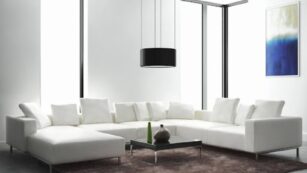
We’ve selected the finest basement wall colors to create a welcoming, fresh, large, contemporary, homely, and peaceful environment.
When undertaking house improvements, it’s easy to ignore the construction and design of basement walls. This is due to the fact that basements are not easily seen. The majority of the time, basements are utilized for storage.
Light and comfort aren’t typically the first things that come to mind when renovating a basement, but a few improvements, such as replacing your basement wall colors with the finest you can find, may make all the difference in the world.
You may transform your basement into a place that is not only useful but also attractive. When it comes to improving your basement, a new coat of paint may be a great place to start.
The Most Appropriate Color For Basement Walls
After the improvements are complete, a mix of colors, combined with the appropriate furniture and accessories, may completely transform how your basement area looks and feels.
You must consider factors such as lighting, wall textures, and personal design tastes in order to choose the ideal color for your basement walls.
Here are some of the finest colors to think about while repainting your basement walls:
White
A bright white color on the basement walls will disperse light and make the room seem larger and brighter overall.
Because it’s the simplest blank canvas to mix and match with accessories and other basement furniture, white is considered a versatile hue.
Off-whites in various hues are also a good option for this area. Off-white is suggested for improved productivity if you wish to establish a basement home office.
Red
Red is a wonderful way to add vitality to any room, and it can certainly liven up a drab basement. It’s also a wonderful hue to choose if you want to turn your basement into an entertainment space, such as a movie room or home theater.
Red may also be used as an accent wall to contrast with the other neutrals.
While red may represent feelings like assertiveness, warmth, and even passion, it also has certain negative connotations.
The disadvantage of red is that it may increase blood pressure by evoking fearful feelings that are opposed to a calm subterranean refuge.
Red is a vibrant hue, but it may not be the greatest option for a peaceful getaway.
Gray
Grays go nicely with simple designs and may really give your basement walls a very neutral and soothing appearance. When combined with colorful textiles and neutral furnishings, grays look fantastic.
This results in a classic appearance that will endure for many years.
Black. Black has a reputation for being gloomy and dark, but when combined with gold and other rustic colours, it can give your basement walls character and a feeling of richness.
The secret to making dark basement walls work is to invest in a superb light fixture.
Yellow
 This is a vibrant hue that may immediately brighten a dimly lit area, such as a basement. Brighter hues of yellow may be difficult to work with since they tend to increase with exposure to sunshine.
This is a vibrant hue that may immediately brighten a dimly lit area, such as a basement. Brighter hues of yellow may be difficult to work with since they tend to increase with exposure to sunshine.
Lighter and warmer hues of yellow, on the other hand, may properly light your basement areas, making it an excellent choice for your basement walls.
Cream
Cream is the ideal combination of beige and pure white colors, producing an enthralling ambiance. This is a warm neutral hue that may be used as a backdrop or an accent.
When combined with woodsy reds and golden honey or something similar, this is ideal.
 Turquoise
Turquoise
Basement walls painted in this color may offer serenity and elevate your basement area since it is the ideal mix of blue and green.
Blue is calming, green is energizing and uplifting, and turquoise is the ideal blend of the two.
When combined with earthy tones, your basement wall may be transformed into a place where you can contemplate and rest.
What Is The Best Basement Wall Color?
Although we’ve previously discussed the basic colors that work well with basement walls, it’d be much better if you had a sense of what colors would be ideal for completed walls.
These hues are very attractive and can brighten up any kind of room, and they also look great on completed basement walls.
Colors for Basement Walls
Here are some of our favorite basement wall paint ideas.
White as ice
Not all white paints are made equally. In order to lighten up your basement walls, use a white hue that complements rather than contrasts with them.
Simple is the greatest tip for obtaining ultra-bright basement walls. Creams and yellow tones should be avoided.
Yellowish tones, such as creams and beiges, should be avoided in regions with little natural light since they may seem filthy.
To obtain a brilliant white hue on the basement walls, use paints with cold undertones.
Cyan is a vibrant color.
A vibrant splash of color in the basement may be a fantastic idea.
Use a bright blue or stunning cyan on the walls of your basement to attract attention to it.
It looks excellent as a statement or accent wall and pairs well with soft furnishings like mattresses and sofas.
Soft gray
Designers like airy gray hues because they are a wonderful way to make the basement walls stand out without making them seem claustrophobic or spooky.
It adds depth to your basement design and works well with both artificial and natural illumination.
Grays may be excellent foundation for mixing and matching paint colors for your basement walls.
Basement Colors in the Modern Era
If you’ve been dealing with anything stuffy or gloomy in the past, inviting and fresh contemporary hues may truly turn your basement decor around. Basements don’t always have to be gloomy.
They are not, however, all the same. A walkout door in your basement may provide plenty of natural light.

Your basement may be made contemporary and current with neutrals and a few bursts of color. Whites are excellent for simulating natural light when selecting paint colors.

For the contemporary palate, blues are also very appealing. The right hues of blue may make your basement seem energizing while also being soothing and refreshing to the eyes.
What Colors Enhance the Size of a Basement?
The idea is straightforward. Light is absorbed by darker hues. In theory, this implies they may make your basements seem smaller and more crowded.
If you want your basement to seem larger than it is, choose white, cream, and other light-reflecting hues.

Another technique is to make sure your baseboards and molding are several shades lighter than your wall. This will visually push the walls back, giving the impression of a much larger area.

This tends to deceive the mind into believing the space is much bigger than it is.
What Are The Worst Paint Colors For Basement Walls?
Basements do not have a one-size-fits-all answer. Every basement is unique, so you’ll have to adapt and make do with what you’ve got.
The quantity of natural illumination that enters your basement is one of the most important factors to consider.
Basements that get a lot of natural light. If your basement gets a lot of natural light, you may want to avoid ultra-bright hues like blinding white or other vivid colors that might damage your eyes if you combine them with a lot of sunshine.
To make it a bit more relaxing on the eyes, use hues with blue or cooler undertones. Basements with plenty of natural light might benefit from some greens, grays, and blues.
Basements that are dark and have little natural light. If your basement, on the other hand, is deficient in natural light, you may want to go with something brighter.
Paints with natural yellowish or warm undertones would be ideal for this kind of area since they would provide a sense of light just by changing the color of the basement walls.
Accent colors like as reds and purples, as well as bright whites and creams, may work well in this kind of basement.
Visit our collection of basement flooring ideas for more ideas like this.
Frequently Asked Questions
What is the best color to paint basement walls?
The best color to paint basement walls is a neutral color like beige.
What color should I paint my unfinished basement?
The color you should paint your unfinished basement is white.
What colors make a basement look bigger?
Blue, green, and purple.
Related Tags
This article broadly covered the following related topics:
- best gray paint for basement
- best paint colors for basement family room
- basement paint colors
- basement paint colors 2017
- basement paint colors 2018





 This is a vibrant hue that may immediately brighten a dimly lit area, such as a basement. Brighter hues of yellow may be difficult to work with since they tend to increase with exposure to sunshine.
This is a vibrant hue that may immediately brighten a dimly lit area, such as a basement. Brighter hues of yellow may be difficult to work with since they tend to increase with exposure to sunshine.
 Turquoise
Turquoise















